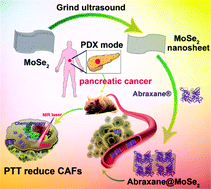Photothermal augment stromal disrupting effects for enhanced Abraxane synergy chemotherapy in pancreatic cancer PDX mode†
Abstract
Cancer-associated fibroblasts (CAFs) are crucial for forming the desmoplastic stroma that is associated with chemoresistance in pancreatic ductal adenocarcinoma (PDAC). In the clinic, depleting dense stroma in PDAC tumor tissue is a promising chemotherapeutic strategy. In this study, we report that the local hyperthermia can reduce the number of CAFs in the PDAC PDX mouse mode, which further augments chemotherapeutic efficiency in the PDAC therapy. To achieve this goal, a photothermal-chemotherapeutic agent termed as Abraxane@MoSe2 as a vehicle-saving theranostic probe is prepared by simply mixing an FDA-approved Abraxane and hydrophobic MoSe2 nanosheets via electrostatic and hydrophobic interactions. After labeling with indocyanine green (ICG) dye on the Abraxane@MoSe2, a relatively high fluorescence signal (near infrared second (NIR II)) in PDX tumors can be obtained, which can be precisely imaging-guide local photothermal-chemotherapy upon the 808 nm laser irradiation in vivo. Importantly, the synergy therapeutic efficiency in PDAC is enhanced by the photothermal effect reduction of the number of CAFs, which is confirmed via α-SMA and vimentin immunofluorescence analysis. This combined therapeutic strategy may provide a new sight for PDAC therapy.



 Please wait while we load your content...
Please wait while we load your content...